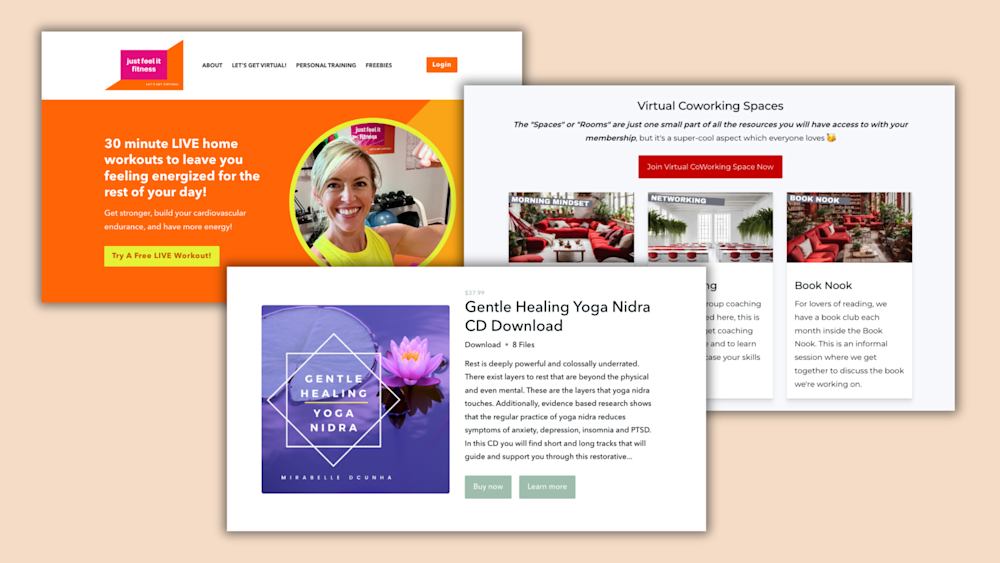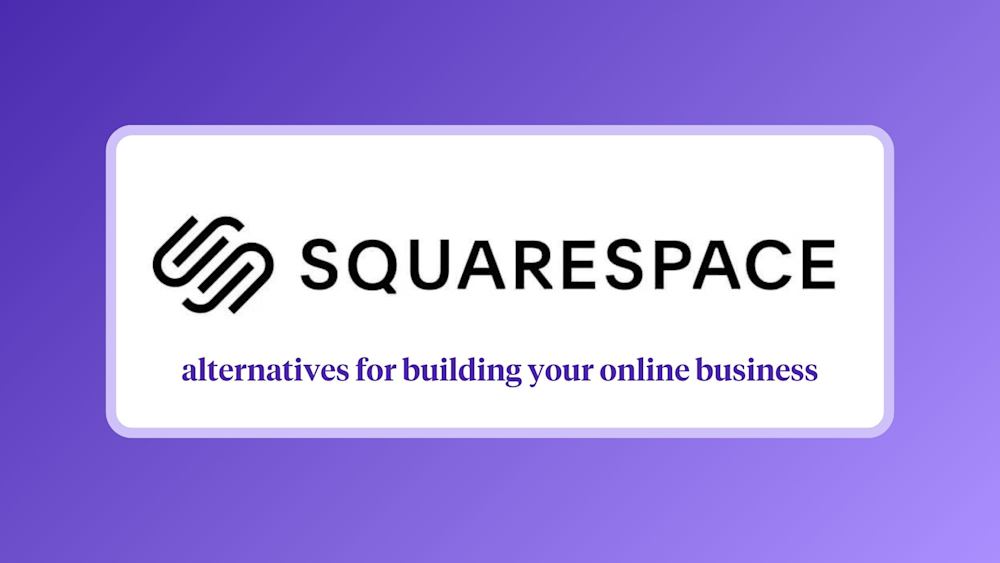“Creators are earning their first ‘online dollar’ by the millions, and they’re joining one of the fastest-growing ecosystems on the planet: the creator economy.”
Len Markidan, Podia’s CMO, wrote those words two years ago — and the creator economy hasn’t slowed down since.
An estimated 50 million people consider themselves to be creators, and there’s more information available than ever on becoming a full-time creator. The phrase “digital creator” is entered into search engines 2.5K times every month, while “how to become a content creator” sees 1.3K searches.
A creator is anyone who creates. Yes, influencers, YouTubers, bloggers, and podcasters are all creators — but so are artists, craft-makers, musicians, educators, worldbuilders, authors, and everyone in between.
That broad spectrum of creative work means that no two creator journeys are identical.
What kinds of products do creators make and sell? What are their biggest challenges? Where do they turn to for advice? Which channels are most successful?
To learn more about what it’s like to run a creator business in 2022, we surveyed 900+ Podia creators about their businesses. We asked them about their challenges, advice sources, creative channels, and content.
Here’s what we found:
-
Across experience levels, creators’ biggest challenge is growing an audience (32.9%), followed by finding enough time for everything (21.6%) and knowing how to monetize (14.4%).
-
When seeking advice to solve those challenges, creators primarily learn from each other. YouTube (22.6%) and personal mastermind groups (22.5%) are the top two places creators turn for advice.
-
Creators are using social media to connect with their audiences, with Instagram as the most popular channel (29.1%) — but that means they have to rely on algorithms to get their content in front of the right people.
Keep reading for a deeper dive into the data.
What are creators’ biggest challenges in 2022?
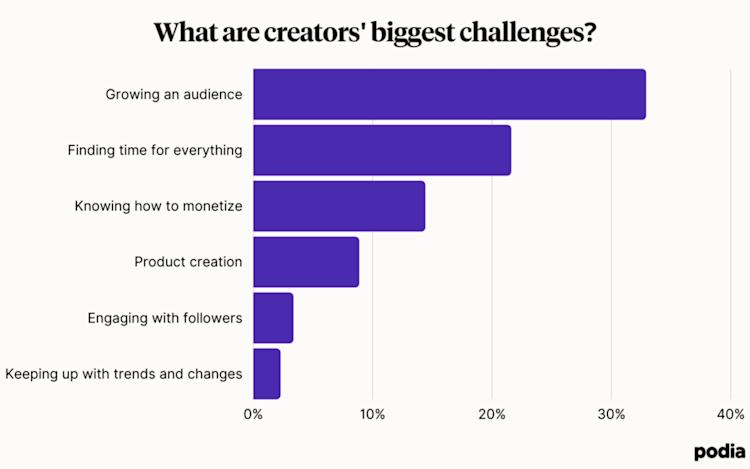
We asked, “What’s your biggest challenge or struggle as a creator right now?”
-
32.9% Growing an audience
-
21.6% Finding enough time for everything
-
14.4% Knowing how to monetize
-
8.86% Product creation
-
3.35% Engaging with followers on social media
-
2.27% Keeping up with trends and changes
Across experience levels and content types, creators consistently reported the same top three challenges: Growing an audience, finding enough time for everything, and knowing how to monetize their work.
Challenge #1: Growing an audience
Nearly one-third of creators struggle to find and connect with their target audience. Lack of time or money and not knowing where to start all contribute to this challenge.
In the same survey, we asked respondents what they would do if they received $2,022 to grow their businesses, and several types of marketing costs made the list:
-
17.8% of creators said they would spend the money on paid social media
and search engine marketing.
-
7.68% would spend the money building or improving their website by hiring
web developers and designers.
-
5.66% would hire a graphic designer, while 4.16% would invest in a
new logo and branding materials.
Getting your content and brand in front of the right people can be time-consuming and expensive, especially if you’re new to running an online business.
One of the best ways to reach your audience is to find out where they already spend time online, then meet them there. You don’t need to be active on every social media platform. Instead, determine which channels are go-to’s for the people you want to see your content.
For example, as she began launching her first products, self-advocacy coach and Podia creator Jessica Wilson also began building her presence on social media platforms. She posted on Instagram, Facebook, and YouTube so that people could get to know her and follow her journey.
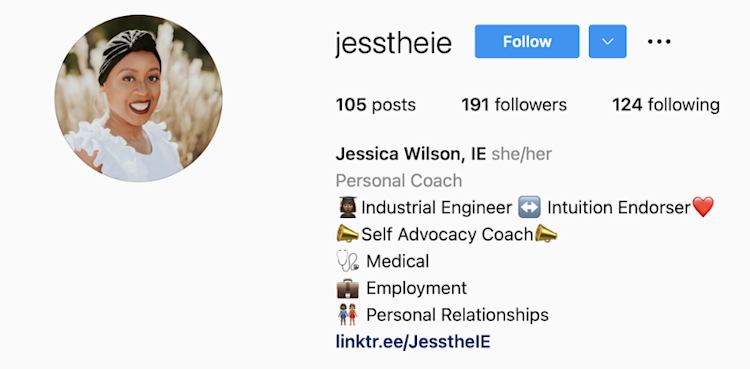
“While you’re still trying to build your email list, you can’t just email folks,” Jessica explained. “I also have to still be very present and very visible on social media.”
As Jessica has become more active and established on social media, she’s been able to find the right platforms and create content that fits her brand and her story. “If you’re trying to build a following, they have to see you very often,” she shared.
She emphasizes that consistency is key — but that doesn’t mean your posts need to be formulaic. “You can do your image posts, you can do [Instagram] Reels and be funny, you can do Reels and be serious … anything to try to diversify how folks can potentially find you.”
Social media can be an effective way to reach more people, but it also means that creators have to rely on the platforms’ algorithms for their content to show up on their audience’s feeds. We’ll talk more about how creators want to — and can — move away from the algorithm later on.
Email is another one of the most cost-effective and scalable marketing channels for creators. Sending out a regular email newsletter keeps you in touch with your audience.
If you’re a creator looking to grow your email list and start an email newsletter, check out these resources:
Challenge #2: Finding enough time for everything
Most creators are solopreneurs. They take on every aspect of running their online business, from marketing and product development to sales and customer support.
That can make task prioritization and time management a real challenge. 21.6% of creators struggle to find enough time to get everything done.
When we asked respondents how they would spend $2,022, investing in external help was by far the most popular answer.
43% of creators want to bring in outside help, including hiring freelancers, virtual assistants, consultants, team members, social media managers, graphic designers, photographers, and videographers.
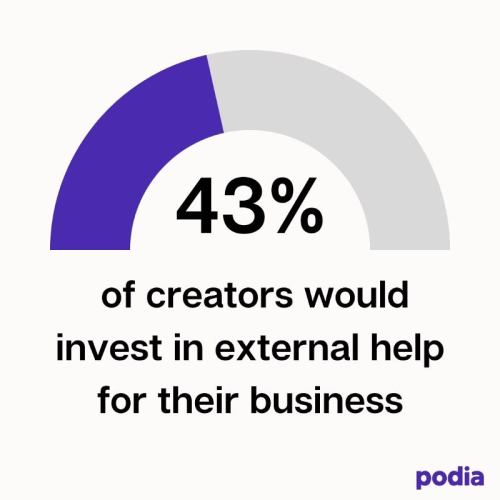
We also found that 5.2% of creators would use the money for personal living expenses like rent, utilities, internet bills, and their own salary to spend more time on their business.
3.42% of creators would spend the money on time-restoring expenses like childcare, household assistance, time off from full-time jobs, and working fewer hours on side gigs.
While money can’t buy extra hours in the day, outsourcing tasks can help creators reclaim their time and get more done. But what if you don’t have the budget to bring on external help?
Choosing the right tools and software can help creators make the most of their valuable time.
There are free and affordable project management, social media management, and productivity tools that make it easier to organize and often automate time-consuming tasks. Zapier, for instance, lets you automate repetitive tasks through “zaps”, which connects the different tools you use and lets them talk to one another.
To keep things even more organized, many creators choose an all-in-one creator platform like Podia. With Podia, creators can create a website and sell online courses, coaching, digital downloads, and webinars — all from one platform.
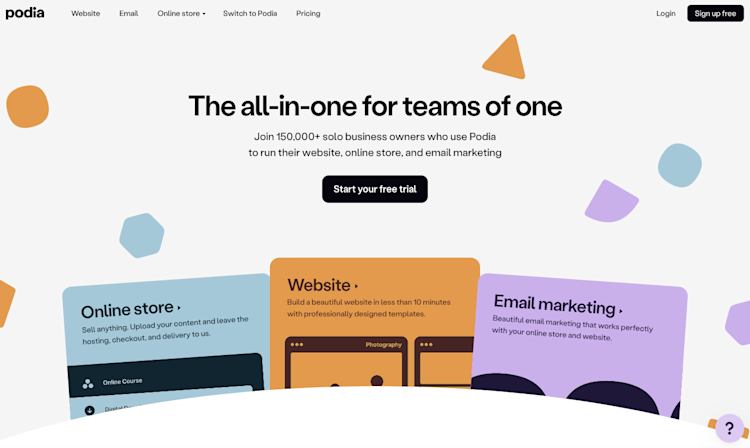
31.42% of creators say that connecting to the rest of their work as a creator is the most important feature when choosing an online community platform. An all-in-one platform makes that connection simple.
Podia also offers built-in live chat, email marketing, and affiliate marketing features, making it easy to market your courses and engage your audience without connecting (or paying for) several different tools.
To see how Podia makes it easier to run a successful creator business, get started with a free 30-day trial today.
Challenge #3: Knowing how to monetize
14.4% of creators say that knowing how to make money from their work is their biggest challenge. You’ve created valuable content and built an engaged audience — now, how do you turn that into income?
There are dozens of monetization options out there: top paying affiliate programs, sponsorships, video monetization on YouTube or TikTok, influencer partnerships, coaching and consulting, digital products, and paid memberships — just to name a few.
At Podia, we’ve watched thousands of creators earn their first online dollar by selling digital products, like online courses, digital downloads, webinars, and community memberships. Selling digital products lets creators make money without relying on sponsors or advertising.
Take entrepreneur, web designer, and creative director John D. Saunders, for example. When he launched his online course on Podia, John earned $10,000 on launch day and $100,000 overall from his Podia site.
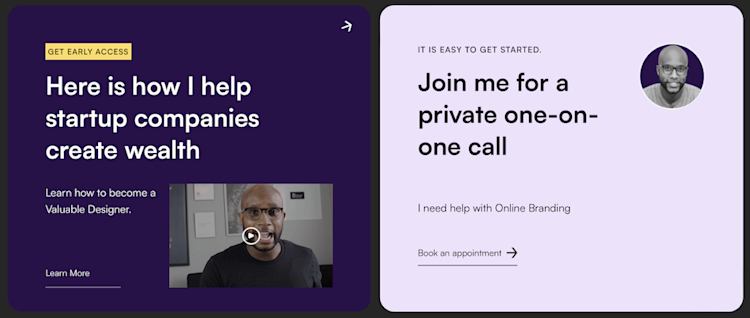
“Passive income isn’t really passive in the beginning, because you do have to create this infrastructure and this infinite pipeline to keep things consistent and going,” John told us.
But once you create your online course, the bulk of the work is out of the way, and you can earn ongoing income. “While I’m sleeping, I’m making income. While I’m out at the park with my family, I’m getting sales,” John explained.
Learn more about monetization options for creators in these articles:
With so many monetization options out there, many creators look to each other for examples, inspiration, and guidance on their own journeys. That brings us to our next key takeaway from the survey: Where creators seek out advice.
Where do creators go for advice?
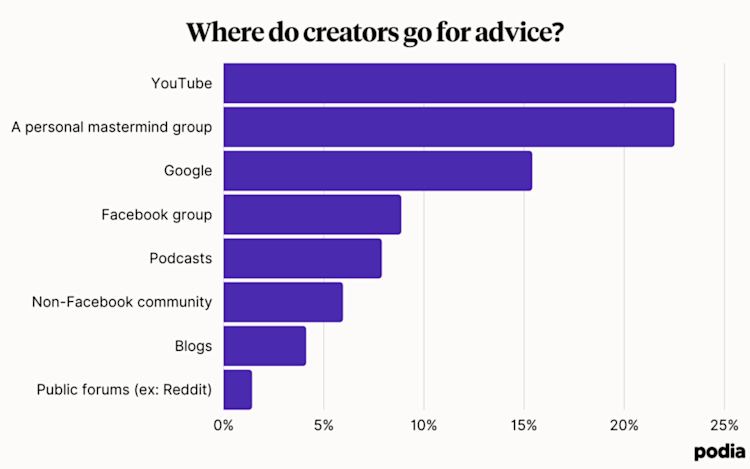
We asked, “What’s the number one place you go for advice to solve your biggest challenge?”
-
22.6% YouTube
-
22.5% A personal mastermind group
-
15.4% Google
-
8.86% Facebook group
-
7.89% Podcasts
-
5.95% Non-Facebook community
-
4.11% Blogs
-
1.41% Public forums (ex: Reddit)
Though no two creator journeys are identical, we know that creators across niches, product types, and experience levels face the same challenges.
It makes sense, then, that they find the answers to and advice on those challenges by asking each other.
Creators learn from other creators. Between YouTube videos, mastermind groups, Facebook groups, communities, forums, podcasts, and blogs, 73.3% of creators surveyed look to other creators for advice.

Google is the only advice source that doesn’t necessarily fit that category — though it’s a safe bet that creators produced a big chunk of the content in the search results, too.
An incredible 76% of internet users participate in some type of virtual community, and 66% of people say they join online communities to meet others who share their interests.
For creators, these communities are a vital resource. Creators connect in order to learn and grow, and we’ve seen successful creators be incredibly generous with their insights and expertise to help new creators.
When we started building the Podia Community, our primary goal was to create a space where creators could learn from one another.

How do other creators run their businesses? What do they sell? Where does most of their revenue come from? How do they build their audiences?
We know that creators have all these questions and often look to each other for answers and inspiration.
We created the Podia Community to:
-
Offer creators and entrepreneurs a place to connect and network with each other
-
Make the creator journey less lonely
-
Give Podia creators a community open only to them
-
Create exclusive content for community members, including courses, creator interviews, and community challenges
Within the first two weeks of opening the community to all Podia creators, we saw over 1600 members and hundreds of posts featuring questions, ideas, and advice.
Experienced creators like Emily Mills contributed helpful posts like this one:
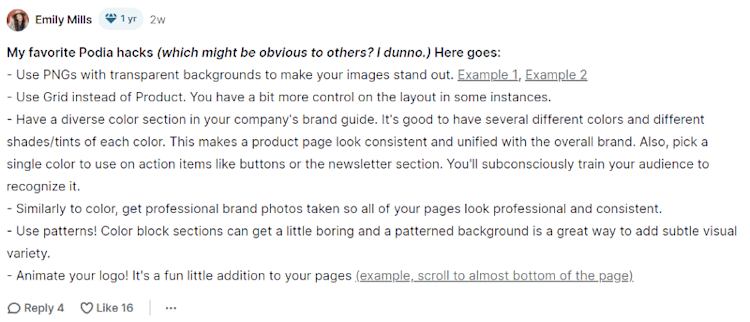
Emily’s Podia hacks served as a great example of how members can learn from each other’s expertise, one of the biggest benefits of joining a creator community.
What types of content do creators produce? Where do they share that content?
We asked, “What is the main form of content you create?”
-
33.6% courses
-
13.8% coaching
-
13.4% social media
-
16.54% video (9.19% short-form, 7.35% long-form)
-
6.38% blog posts
-
4.76% downloads
-
4.43% email newsletters
-
2.81% webinars

Over one-third of people who filled out the survey create online courses as their main form of content. After courses, coaching, social media, and video were the most popular types of content.
Here are some resources for creators looking to build and sell an online course:
-
What is an ecourse, and do they actually work for making money online?
-
13 essential tools to create, record, and sell your online course
-
The ultimate formula for launching and growing your online course
We also learned that creators sell an average of 10.95 products.
We then asked, “What’s the primary channel you use for your business?”
-
29.1% Instagram
-
22.4% Podia
-
17.4% Facebook
-
8.97% YouTube
-
5.41% Blog
-
5.08% Zoom
-
2.49% TikTok
-
0.865% Shopify
-
0.541% Etsy
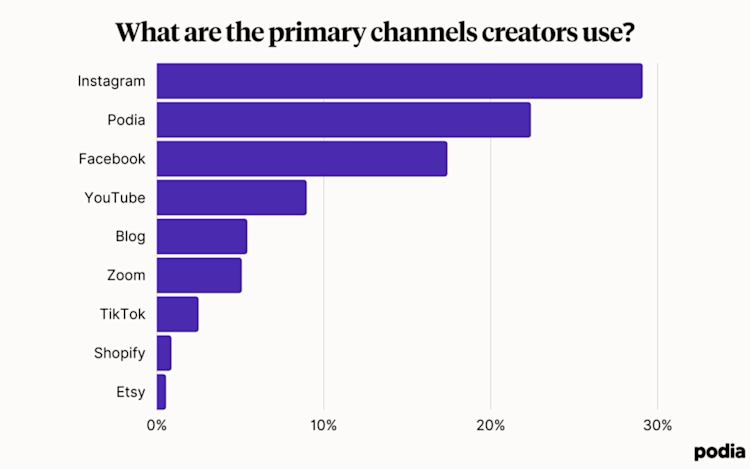
Creators are using social media to connect with their audiences, with Instagram as the most popular social channel (29.1%), followed by Facebook (17.4%) and YouTube (8.97%).
As we mentioned earlier, social media can be a terrific way for creators to reach new audiences and establish themselves within their niches and communities. But there’s one major downside to relying on social media: The algorithm.
Social media platforms use algorithms to determine what content appears on users’ feeds.
Creators are at the mercy of these algorithms — your organic content might show up in your followers’ feeds, but it also might not. The algorithms can change without warning, and social media companies are far from transparent about how they work.
For example, updates to the Facebook algorithm over the past few years have led to a decrease in organic reach, meaning fewer followers see creators’ social posts in their news feeds.
That lack of control is just one reason creators aren’t happy with Facebook. 74% of creators use Facebook for their communities — but 88% of them want to switch to a new community platform.
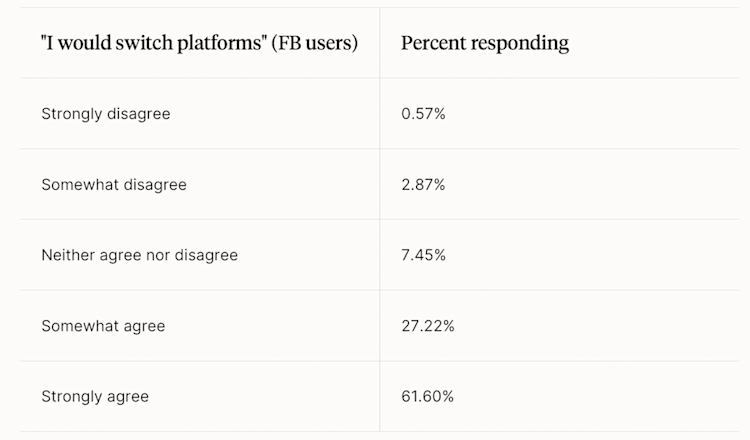
Here are a few more reasons creators dislike using Facebook:
-
“I think FB is too distracting, and members either won’t find my content or won’t stick around.”
-
“FB groups are untrustworthy and gimmicky, and people are running from FB right now, so it’s hard to create engagement there.”
-
“I really hate sending my people to Facebook or similarly shady tech companies that harvest data and use it to hook us on distraction.”
-
“I have to pay a full-time VA to admit members, welcome them, moderate, etc. We have Google Sheets and separate Facebook Messenger software that costs $30/month, plus we are slaves to Facebook’s algorithm and distractions. It’s such a mess.”
Creators tend to build digital communities on social media platforms for lack of a better solution. Facebook Groups make it easy to log in, but that’s where most of the benefits end.
On the other hand, an all-in-one creator platform like Podia gives you complete control over which content you serve up to your audience and how you interact with them.
Members can:
-
Buy your products
-
Access your content
-
Read your articles
-
Sign up for your email list
-
Comment on your course lessons and blog posts
…all in the same place.
All in all, social media can be a useful marketing tool for creators — but it’s best used as a piece of a larger strategy and toolset. Creators succeed when they have control over how and to whom they share their content.
Who filled out the survey?
In February 2022, we announced the first Podia Creator Fellowship. The winner received $2,022 for their business and a one-on-one coaching session with successful creator Khe Hy.
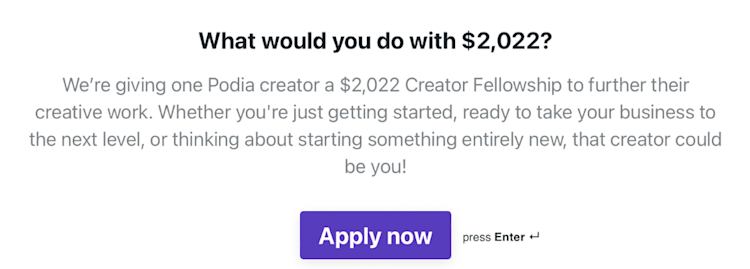
To apply for the fellowship, applicants had to be current Podia creators and members of the Podia Creator Community. They filled out an application telling us how they would spend the prize money, as well as information about their business, products, challenges, and goals.
Most of the data in this article comes from questions where creators were asked to choose from several answers. For the question, “If you won the $2,022 fellowship, what would you spend it on?” we included an open-ended answer field.
We received over 900 incredible applications.
When asked about their experience level:
-
30.85% identified as beginners, with an average of 2.40 years of experience
-
8.11% identified as novices, with an average of 2.77 years of experience
-
40.98% identified as mid-level, with an average of 4.98 years of experience
-
15.80% identified as advanced, with an average of 7.69 years of experience
-
4.27% identified as experts, with an average of 15.3 years of experience
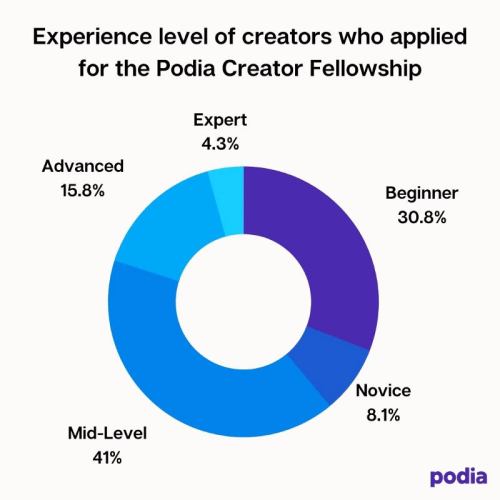
We also asked whether they’re a full-time creator, part-time creator, or somewhere in between:
-
39.13% identified as a full-time creator
-
18.81% identified as a creator with a separate full-time job
-
18.59% identified as a creator + freelancer
-
14.70% identified as a part-time creator
-
8.76% identified as a creator with a separate part-time job
Products sold by the creators surveyed include art classes, business mindset coaching, educational ebooks, templates and printables, music lessons, resources for early childhood educators, self-advocacy coaching, and much, much more. This gave our data a unique range of perspectives.
Thank you to every creator who applied for the fellowship and gave us a peek inside their ideas, challenges, and journeys.
Key takeaways
The creator economy is growing, and no two creator journeys are identical. We surveyed over 900 creators to learn more about what it’s like to run a creator business in 2022.
Here are the key takeaways from their responses:
-
Creators across niches and experience levels run into the same three main challenges: Growing their audiences (32.9%), finding enough time to get everything done (21.6%), and knowing how to monetize their work (14.4%).
-
When creators look for advice to overcome these challenges, they turn to other creators. Community is a crucial part of the creator journey. More experienced creators have been in newer creators’ shoes, so they have plenty of valuable insights to share.
-
Creators primarily use social media to share their content with their audience, with Instagram as the most popular channel (29.1%). Relying on social media means creators are at the mercy of the algorithms, giving them less control over their content and audience.
Of the 900+ responses we used to calculate this data, no two were identical. Every creator journey is different — and we’re here to support you at every stage. Start your free trial of Podia today.


